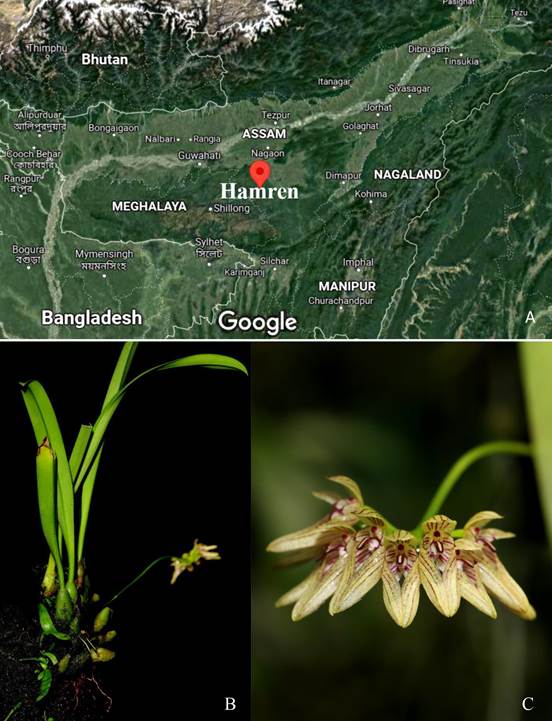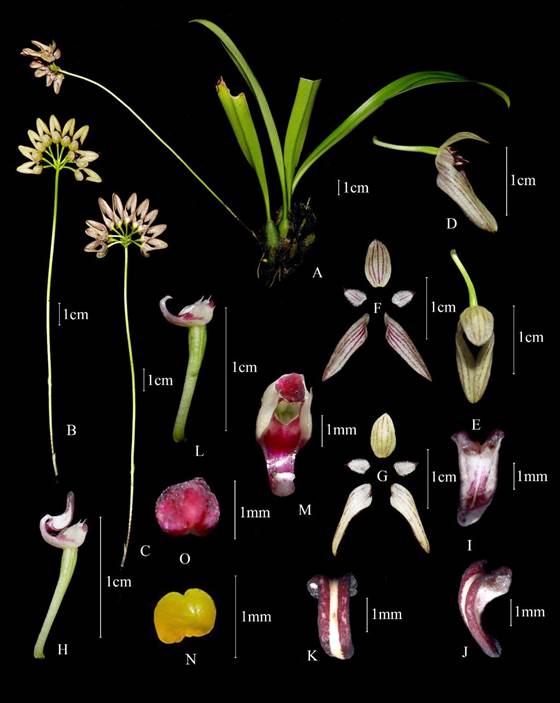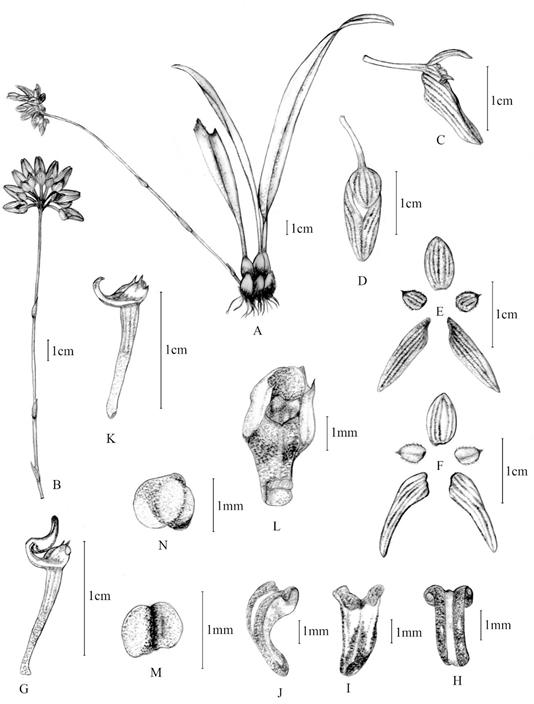Introduction
The genus BulbophyllumThouars (1822) is one of the largest plant genera in Orchidaceae, with over 2200 species distributed in the tropics and subtropics of the world (Vermeulen et al. 2014). Currently, more than 121 species have been recorded in India (Misra 2019). Gogoi (2019) reported 40 species of Bulbophyllum from the state of Assam. During a field trip to the forested area of Hamren of Karbi Anglong District of Assam on 14 March 2018, an unknown Bulbophyllum species was found without flowers, which could not be determined immediately. Therefore, the orchid was put in cultivation at the Regional Orchids Germplasm Conservation & Propagation Centre (Assam Circle), where plants flowered under observation on 20 May 2021. Unfortunately, the species could not be matched with any existing species in the region and adjacent areas.
Thorough morphological studies revealed that the new species belongs to Bulbophyllum section Cirrhopetaloides Garay, Hamer & Siegerist (Vermeulen et al. 2014). It is characterized by creeping rhizome; 1-leaved pseudobulbs; subumbellate raceme arising from the base of pseudobulbs; free dorsal sepal, entire, erose, fimbriate, ciliate, or paleate along the margin; lateral sepals glabrous, twisted at the base and adnate (entirely or in part) along one or both margins. Petals are denticulate or fimbriate along the margin; lip simple; stellidia usually shorter about half of the column length, usually with tooth above and wing below. Pollinia 4, without stipe. The section contains around 19 accepted species distributed from Sri Lanka, India, China, Taiwan, Japan, Myanmar, Thailand, Indochina, Peninsular Malaysia, Sumatra, Borneo, and the Philippines.
After careful examination and comparison with existing species with the help of available literature (Averyanov et al. 2015, Chen et al. 2009, Chowdhery 1998, Gale et al. 2010, Gogoi 2014a, 2014b, 2018, 2019, Gogoi & Yonzone 2013a,b,c, Hegde 1917, Hooker 1890, King & Pantling 1898, Lucksom 2007, Misra 2019, Pearce & Cribb 2002, Pradhan 1979, Rao 2010, Singh et al. 2019) and critical examination of herbarium specimens deposited in ASSAM, ARUN, CAL and type images present in K, E, and PE. As a result, it is confirmed to be a hitherto undescribed species. Hence, we describe the same here along with colour plates and line drawings. We also compare it with is closest allies, i.e., B. bicolor Lindl., B. venulosum J.J.Verm. & A.L.Lamb and B. blaoense Tich & Diep ex Aver. & Tich.
Materials and methods
The measurements and species description were made from living plants. Type is deposited at the Herbarium of the Orchid Research Centre Tipi, Arunachal Pradesh (OHT) and Herbarium of The Orchid Society of Eastern Himalaya (TOSE- HIM), Regional Orchid Germplasm Conservation and Propagation Centre (ASSAM), Assam. All the photos were taken with a Canon 6D Mark-II fitted with an EF 100 mm f/2.8L Macro USM lens. The terminology for the morphological description follows Beentje (2012).
Table 1 Diagnostic features of Bulbophyllum blaoense, B. bicolor, karbianglongensis, and B. venulosum.
| Character | B. blaoense | B. bicolor | B. karbianglongensis | B. venulosum |
|---|---|---|---|---|
| Rhizome | Rigid, semi-woody, 0.2-0.3 cm in diameter | Several-noded rhizome 0.25-0.5 cm in diameter | Short, 0.5 cm diameter | 0.15-0.25 cm diameter, 1.8-9.0 cm long |
| Pseudobulbs | Distant from each other 1-3 cm, broadly ovoid to almost globular or slightly oblate, 0.5-0.7 cm tall and wide, young enveloped by tubular sheaths | Distant from each other 3.5-5.5 cm, ovoid, 2-2.5 × 1.2-1.5 cm, prominently angled, enclosed in a basal sheath that withers with age | Clustered together, narrowly ovoid to conic, 1.5-2.5 × 0.8-1.8 cm, with 3 bracts sheathing towards the base | 1.2-1.8 × 0.7-1.2 cm, distinctly 4 angled, ovoid to ellipsoid |
| Leaves | Sub-sessile, broadly lanceolate to narrowly ovate, 6-12 × 1.4-2.5 cm, acute to shortly unequally bilobed | Oblong, channeled, 11-16 × 2.5-4 cm, obtuse. | Elliptic-lanceolate, 15-17.5 × 1.4-1.6 cm, acute to acuminate, channeled. | Ovate, 3.1-12.5 × 2.6-4.3 cm |
| Inflorescence | Umbel, 7-12 cm long, 2- 5 flowers | Subumbellate, 5-7.5 cm long, with 3-6 flowers | Subumbellate, 15-19 cm long, 5-10 flowers | Subumbellate, 8-14 cm long, 4-9 flowers |
| Floral bracts | Slightly concave, acuminate, 0.3- 0.4 × 0.1-0.1.5 cm | Narrowly-ovate, 0.5-0.7 × 0.15-0.2 cm | Lanceolate, acute, 0.4-0.5 × 0.1 cm | 0.2-0.35 cm long |
| Flowers | Tepals dull pale yellow marked with purple-brown, purple-violet at apex; lateral sepals almost white striped with dull purple along nerves; lip adaxially light dull yellowish, little flushed with purple at the base, almost white spotted with light purple at abaxial surface | Tepals pale greenish- yellow with purplish- red to maroon dots and flecks forming lines on both surfaces, apex of dorsal sepals and petals tinged deep purplish- red | Tepals greenish yellow with purple nerves, lip dark red/purple with prominent median white band running from the base to the apex | Tepals white or slightly yellow, sometimes suffused purple proximally with purple nerves; petals with purple in the median area white towards the margins; lip white, spotted purple, or purple, white towards the margins and the apex |
| Dorsal sepal | Shortly attenuate, concave, 0.9-1.0 × 0.5-0.6 cm, margins denticulate and ciliate. | 1.1-1.4 × 0.6-0.9 cm, apex acuminate, margins ciliate, seven nerves. | 0.7-0.72 × 0.4-0.42 cm, entire, with 5 purple nerves, obtuse. | 0.45-0.5 × 0.3-0.42 cm, porrect or recurved, acute to shortly acuminate, margins short fimbriae except near the base, with 5 purple nerves. |
| Lateral sepals | Narrowly triangular, elongate, oblique, connivent along upper apical half, 2.6-3 × 0.5-0.6 cm | Obliquely ovate- lanceolate, 1.9-2.5× 0.6-0.8 cm, acute, lower margins connate at the base, seven nerves | Oblong, 1.2-1.3 ×0.25-0.3 cm, with 5 nerves, obtuse, connate along upper margin | Oblique, oblong, 1.4-2.0× 0.3-0.45 cm, porrect, curved inwards at the base and connate along the upper margin |
| Petals | Ovate to broadly ovate, slightly oblique, triangular, acute to acuminate, 0.6-0.8 × 0.4 -0.5 cm, margins denticulate and ciliate, 5 nerves | Rotund-ovate, slightly oblique, 0.8-1.0× 0.5-0.6 cm, apex rounded and mucronate, margins entire to minutely denticulate. | Obliquely ovate, 0.3-0.31 × 0.2-0.21 cm, acute to acuminate, margins minutely ciliate, keeled, 3 nerves with purple apex | Recurved, obliquely ovate- triangular, 0.42-0.55 ×0.22-0.33 cm, obtuse, margins fimbriate, papillose distally, 3 nerves |
| Lip | 0.5-0.6 cm long, densely papillose on adaxial surface, not grooved | 0.8 × 0.4-0.5 cm, not grooved | 0.3 × 0.1 cm, base grooved, prominent median white ridge running from the base to the apex | 0.32-0.4 × 0.19-0.25 cm, grooved, median ridge most of the length |
| Column | 0.25 - 0.32 cm long, foot up to 0.7 cm long | ca. 0.3 cm long, foot 0.7-0.9 cm long | Column 0.15 cm long; foot 0.5 mm long | 0.16-0.2 cm long; foot adaxially with a median tooth and 2 slight lateral wings at the apex |
| Stellidia | Mucronate, slender, with small triangular tooth above, broadly triangular wing below, apex obtuse | Subulate, slightly downcurved, with acute tooth above, triangular wing below, apex obtuse. | Slender, pointing forward, truncate tooth above, triangular wing bellow | Porrect, triangular, acute, with a small, pointing upward, deltoid, acute tooth along the upper margin and a slight, deltoid rounded wing along the lower. |
| Anther cap | Hemispheric, yellowish to yellowish-green | Ovoid | Subglobose, papillose, purple | Globose, purple |
| Distribution | Endemic to Vietnam | Hong Kong and Vietnam | India (Hamren of Karbi Anglong, Assam) | Endemic to Borneo |
Taxonomic treatment
Bulbophyllum karbianglongensis K.Gogoi & R.Hondiqui, sp. nov.
TYPE: India. Assam: Karbi Anglong District, Hamren, 500 m, 14 March 2018, (flowered in cultivation 20 April 2021), K. Gogoi and R. Hondiqui 00953 (holotype: Orchid Herbarium Tipi; isotype: ASSAM, Herbarium of the Orchid Society of Eastern Himalaya), (Fig. 1 - 3).
Diagnosis: Bulbophyllum karbianglongensis resembles B. bicolor, B. venulosum, and B. blaoense but differs in clustered, narrowly ovoid to conic pseudobulb; elliptic-lanceolate leaves; flowers greenish-yellow with purple nerves, lip dark red/purple with a prominent median white band running from the base to the apex, dorsal sepal ovate-oblong, entire; stellidia slender, pointing forward, truncate tooth above, winged bellow. Detailed morphological differences between these species are presented in Table 1.
Plants epiphytic, pseudobulbous, pseudobulbs borne on creeping rhizome. Rhizome stout, short, ca. 0.5 cm diameter. Pseudobulbs clustered together, narrowly ovoid to conic, 1.5-2.5 × 0.8-1.8 cm, 3 bracts sheathing towards the base, with a terminal leaf. Leaves single, elliptic-lanceolate, 15.0-17.5 × 1.4-1.6 cm, acute to acuminate, fleshy, petiolate; petiole 2 cm long, channeled. Inflorescence arising from the base of the pseudobulb, erect or sub-erect, longer than leaves, yellowish-green, bearing a subumbel of 5-10 flowers; peduncle slender, ca. 0.2 cm in diameter, 15-19 cm long, with 2 or 3 tubular sheaths; floral bracts greenish-yellow, lanceolate, 0.4-0.5 × 0.1 cm, acute, shorter than pedicel and ovary; pedicel (with ovary) ca. 1 cm long, slender. Flowers 1.4-1.5 × 0.5-0.4 cm, greenish- yellow with purple nerves. Dorsal sepal ovate-oblong, concave, entire, 0.70-0.72 × 0.42-0.42 cm, 5-veined, apex obtuse. Lateral sepals oblong, 1.2-1.3 × 0.25- 0.30 cm, 5-veined, apex obtuse, base adnate to column foot, twisted near the base, connate along upper margin. Petals obliquely ovate, 0.30-0.31 × 0.20-0.21 cm, apex acute to acuminate, margins minutely ciliate, keeled, 3-veined, with purple apex. Lip dark red/ purple with a prominent median white band running from the base to the apex, recurved, ligulate, 0.3 × 0.1 cm, fleshy, base grooved, attached to the column foot by a mobile joint, side lobes inconspicuous. Column ca. 0.15 cm, stellidia slender protruding forward, ca. 0.05 cm long, upper with small tooth for each side, the lower margin of column broadly winged; foot 0.15 cm, upcurved. Pollinia 0.05 cm, yellow, anther cap subglobose, papillose, 0.1 × 0.1 cm, purple.
Etymology
The specific epithet refers to the ''Karbi Anglong'' district of Assam, in Northeast India, where the plant was collected.

Photos by K. Gogoi.
Figure 1 A. Distribution map of Bulbophyllum karbianglongensis. B. Habit of Bulbophyllum karbianglongensis. C. Bulbophyllum karbianglongensis inflorescence.

A. Habit.
B. Ventral view of inflorescence.
C. Dorsal view of inflorescence.
D. Side view of flowers.
E. Ventral view of flower.
F. Ventral view of perianth.
G. Dorsal view of perianth.
H. Lip with ovary and column.
I. Dorsal view of lip.
J. Side view of lip.
K. Ventral view of lip.
L. Ovary with pedicel and column.
M. Front view of column.
N. View of pollinarium.
O. Anther cap ventral view.
Photos by K. Gogoi.
Figure 2 Bulbophyllum karbianglongensis.

A. Habit.
B. Ventral view of inflorescence.
C. Side view of flowers.
D. Ventral view of flower.
E. Ventral view of perianth.
F. Dorsal view of perianth.
G. Lip with ovary and column.
H. Ventral view of lip.
I. Dorsal view of lip.
J. Side view of lip.
K. Ovary with pedicel and column.
L. Front view of column.
M. View of pollinarium.
N. Anther cap ventral view.
Drawing by K. Gogoi.
Figure 3 Bulbophyllum karbianglongensis












 uBio
uBio 

